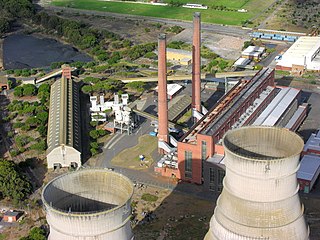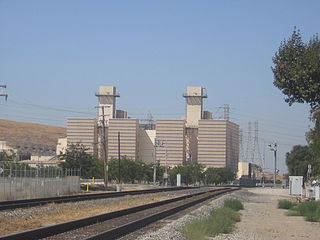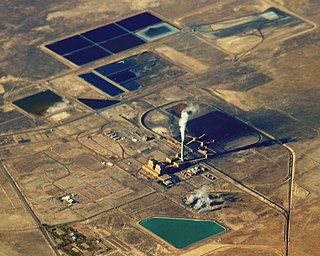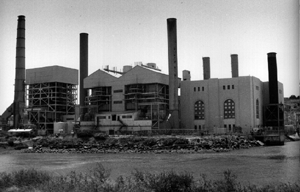The Los Esteros Critical Energy Facility is a power plant in San Jose, California, operated by Calpine. Located near the San Jose-Milpitas border, it began operations in 2003 with an initial capacity of 188 megawatts. [1] In 2013 it was upgraded to 309 megawatts. [2] The facility uses four natural gas turbines run as a combined-cycle facility where the exhaust from the gas turbine is used to create steam that drives a steam generator. [1]

A power station, also referred to as a power plant and sometimes generating station or generating plant, is an industrial facility for the generation of electric power. Power stations are generally connected to an electrical grid.

Peaking power plants, also known as peaker plants, and occasionally just "peakers", are power plants that generally run only when there is a high demand, known as peak demand, for electricity. Because they supply power only occasionally, the power supplied commands a much higher price per kilowatt hour than base load power. Peak load power plants are dispatched in combination with base load power plants, which supply a dependable and consistent amount of electricity, to meet the minimum demand.

The Thomas C. Ferguson Power Plant consists of dual natural gas fired turbines and a single steam turbine run by exhaust heat from the gas turbines in a combined cycle configuration that generates 540 megawatts (MW) of electricity. The facility is located near Horseshoe Bay in Llano County, Texas, United States. It is owned and operated by the Lower Colorado River Authority (LCRA) and was named for Thomas C. Ferguson, a member of LCRA's first Board of Directors. Cooling water is provided by Lake LBJ, a freshwater reservoir created by Wirtz Dam.

The Moss Landing Power Plant is a natural gas powered electricity generation plant located in Moss Landing, California, United States, at the midpoint of Monterey Bay. Its large stacks are landmarks, visible throughout the Monterey Bay Area. The plant is owned and operated by Houston-based Dynegy and currently has a generation capacity of 1020 MW (net) from its two combined cycle generation units. It was once the largest power plant in the state of California, with a generation capacity of 2560 MW, before its two large supercritical steam units were retired in 2016.

Calpine Corporation is the largest generator of electricity from natural gas and geothermal resources in the United States, with operations in competitive power markets.

The Metcalf Energy Center is a 605 megawatt combined cycle power plant located in Silicon Valley, located in unincorporated Coyote Valley, south of San Jose, California and north of Morgan Hill, California. The power plant is owned by Calpine and powered by natural gas. Some of the power generated by the plant is sent to far away places via Path 15, a major electrical power transmission corridor that is connected to the power plant.

The Geysers is the world's largest geothermal field, containing a complex of 18 geothermal power plants, drawing steam from more than 350 wells, located in the Mayacamas Mountains approximately 72 miles (116 km) north of San Francisco, California.
The Westinghouse Combustion Turbine Systems Division (CTSD), part of Westinghouse Electric Corporation's Westinghouse Power Generation group, was originally located, along with the Steam Turbine Division (STD), in a major industrial manufacturing complex, referred to as the South Philadelphia Works, in Lester, Pennsylvania near to the Philadelphia International Airport.

Rock River Generating Station was an electrical power station located north of Beloit, Wisconsin in the town of Beloit at 827 W. B. R. Townline Road on the west bank of the Rock River. The facility was owned and operated by Wisconsin Power and Light, a wholly owned subsidiary of Alliant Energy.

RockGen Energy Center is a 503-megawatt (MW) natural gas fired peaking power plant located near Cambridge, Wisconsin. According to Calpine, it was the largest peaking plant in Wisconsin at the time it was constructed.

The Potrero Generating Station was a natural gas and diesel burning electricity generating station owned by Mirant and located on a 23-acre (9.3 ha) site in Potrero Point, San Francisco, California. The plant's primary power source was a 206 MW, natural gas burning steam turbine providing baseload power and referred to as "Unit 3". In addition, three 52 MW peaking power diesel generators provided additional power during times of highest consumption. Since the closure of the Hunters Point Power Plant in 2006, Potrero was the last remaining fossil fuel power plant within the confines of San Francisco, with capacity to provide approximately 1/3 of the city's peak electrical power needs.

The Ivanpah Solar Electric Generating System is a concentrated solar thermal plant in the Mojave Desert. It is located at the base of Clark Mountain in California, across the state line from Primm, Nevada. The plant has a gross capacity of 392 megawatts (MW). It uses 173,500 heliostats, each with two mirrors focusing solar energy on boilers located on three 459 feet (140 m) tall solar power towers. The first unit of the system was connected to the electrical grid in September 2013 for an initial synchronisation test. The facility formally opened on February 13, 2014. In 2014, it was the world's largest solar thermal power station.

Intermountain Power Plant is a large coal-fired power plant at Delta, Utah, US. It has an installed capacity of 1,900 MW, is owned by the Intermountain Power Agency, and is operated by the Los Angeles Department of Water and Power. The plant includes a HVDC converter. It is scheduled in 2025 for replacement with an 840 MW natural gas plant, designed to also burn "green hydrogen."
Repowering is the process of replacing older power stations with newer ones that either have a greater nameplate capacity or more efficiency which results in a net increase of power generated. Repowering can happen in several different ways. It can be as small as switching out and replacing a boiler, to as large as replacing the entire system to create a more powerful system entirely. There are many upsides to repowering.
The Russell City Energy Center (RCEC) is a 619-megawatt natural gas-fired power station, which began operating in August 2013. It is operated by Calpine, and is located in Hayward, California. It is named for Russell City and is built on that community's former landfill site.

The Donald Von Raesfeld Power Plant (DVRPP) is a natural gas power plant in Santa Clara, California, operated by Silicon Valley Power. Located near the San Jose International Airport it began operations in 2005 with a peak capacity of 147 megawatts.

The Hunters Point Power Plant (HPPP) was a fossil fuel-fired power plant in the India Basin neighborhood of the Bayview-Hunters Point area covering southeastern San Francisco, California, operated by Pacific Gas and Electric Company (PG&E) from 1929 to 2006. After HPPP shut down, the last electric power plant in San Francisco was the Potrero Generating Station, which subsequently shut down in 2011.

Gateway Generating Station (GGS), formerly Contra Costa Unit 8 Power Project, is a combined-cycle, natural-gas-fired power station in Contra Costa County, California, which provides power to half a million customers in northern and central California. Gateway Generating Station is on the southern shore of the San Joaquin River, in Antioch, and is one of more than ten fossil-fuel power plants in Contra Costa County.

The San José–Santa Clara Regional Wastewater Facility is a wastewater treatment plant located in the Alviso neighborhood of San Jose, California. The facility treats 110 million U.S. gallons of wastewater per day, with a capacity of up to 167 million U.S. gal/d (630 ML/d), making it the largest tertiary treatment plant in the western United States. It serves 1.5 million residents and over 17,000 business facilities in eight cities. The 2,600-acre (1,100 ha) site is operated by the San Jose Environmental Services Department and jointly owned by the cities of San Jose and Santa Clara. It began operations in 1956 to address severe water pollution issues and played a key role in San Jose's aggressive annexation program during the 1950s and 1960s.
Bethpage Energy Center is a power station in Bethpage, New York, United States, consisting of two combined cycle plants opened in 1989 and 2005, and one gas turbine peaking plant opened in 2002. The original plant was commissioned by Grumman Aerospace for its Bethpage complex because it was deemed more cost-effective than purchasing power from electric utilities. It was acquired by Calpine in 1998, which expanded the facility with two more plants.